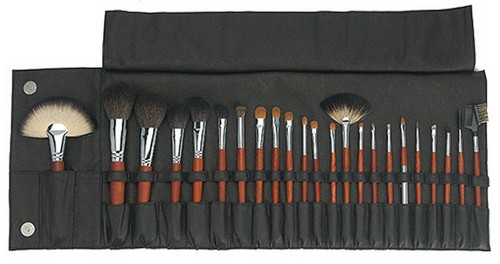Makeup Brushes: Which Fiber is Best
Thanks to my posts on Style Bust, I’ve been learning more and more about quality cosmetics and have been slowly substituting my old drug store brands with better ones like Nars, Smashbox, L’ancome and others. Of course, I do have some favorite brands like Avon and Almay that will continue to be included in my makeup case. And as my makeup case evolves, so do my makeup brushes.
Once upon a time, I either used whichever brush came with the makeup or had some cheap ones lying in the bottom of my case. A couple of years ago, I gave my sister a set of Sable Hair brushes for her birthday. My sister became a makeup application expert ever since she spent her nights trying out different techniques as a teen. She is the go-to makeup girl in my family for parties and special events, and she enjoys doing it.
When she saw the set of brushes, she was speechless and even though we were in the middle of having cake, she could not resist it and started applying makeup on my face in order to try them out; of course, I didn’t complain.
The point of my long winded introduction is to emphasize the importance of having the right makeup brush for your needs. As I’ve been researching for this article, I find there is too much information to add in one post. I decided to divide it in three parts:
- A summary of the types of fibers available
- Basic makeup brushes and how to use them
- Advanced makeup brushes and how to use them
And now, let’s talk about makeup brush fibers.
Makeup brush fibers can be either natural made from animal hair or synthetic. Both of them have a place in makeup collections, depending on what type of cosmetic is being applied.
Goat Hair is the most common fiber used for makeup brushes. They are good at holding large amounts of powder and are a good choice for blush, bronzer and face powder since the makeup won’t get trapped in the brush and you’ll get an even application.
Sable Hair is soft and fine and makeup brushes made of this hair typically have pointy tips. The pointy shape and softness of sable hair makes it an ideal choice for eyeshadow and eyeliners.
Pony Hair is strong and durable. It tends to have a cylindrical shape where there is a consistent thickness from root to tip. Pony hair is a versatile fiber and is good for powder, blush and eyeshadow makeup brushes.
Camel Hair is a generic term used to described makeup brushes that are made with a mix of squirrel, goat or pony hair.
Squirrel Hair is the softest natural hair type and also the most expensive brushes. Similar to sable hair, the brushes are wide in the middle and have a pointed tip, which makes the ideal as blending brushes and for use on eye creases.
Synthetic makeup brushes are made of nylon, which is less absorbent than natural hair fibers. Because they are less absorbent, synthetic brushes are typically used for applying liquid-based products. Synthetic brushes typically do not last as long as natural fiber brushes.
A mix of natural and synthetic fibers is typically referred to as duo fiber brushes. This mix of fibers increases the durability, stiffness and liquid handling ability of the makeup brush.
I understand that after making it a point to buy cruelty-free cosmetics, the option of using animal hair in order to apply them is not appealing. Thankfully there is a synthetic fiber called Taklon which is designed to have anti-bacterial qualities, as well as softness, versatility and durability. Companies like Branded J, Origins, Sevi Cosmetics and many others offer these brushes.
If you are purchasing the brushes online, I’ve noticed that natural hair brushes don’t specify which hair it is. Regardless of which type of brush you decide on, I suggest to go to the store and feel them against your hand. There is nothing better than to feel that gentle touch on your skin, it’ll make Monday mornings a little bit nicer.

